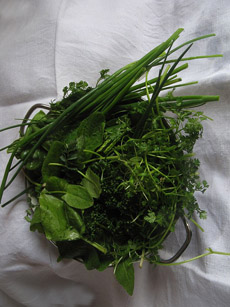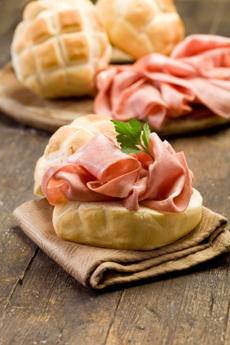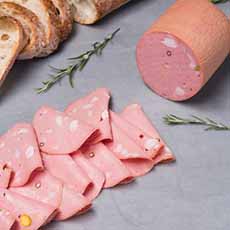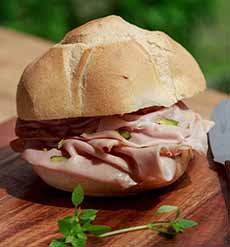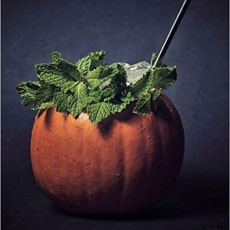
[1] Olive oil-poached salmon (photo © Pom Wonderful).

[2] Sunchokes (Jerusalem artichokes) grow underground like potatoes, and can be cooked in the same ways (photo © Melissa’s Produce | Facebook).
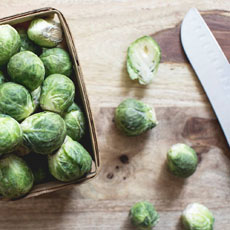
[3] The smaller the Brussels sprouts, the more tender (photo © Sweetgreen).
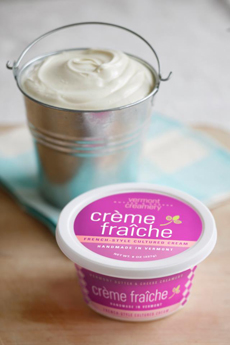
[4] Crème fraîche is cultured cream like sour cream, but without the latter’s tanginess (photo © Vermont Creamery).

[5] Sliced almonds can be tossed into just about anything, from yogurt and scrambled eggs to salads and grain dishes (photo © Happy Belly | Amazon).

[6] Sprigs of fresh rosemary (photo © Burpee).

[7] Fresh thyme (photo © Good Eggs).

[8] Pomegranate juice, required for the jus (sauce), can also be used for cocktails before dinner (photo © Pom Wonderful).
|
|
Here’s a recipe that tastes and looks great year-round. With brussels sprouts and spiced cider, it’s especially fitting for fall. The recipe is from Chef Chris Parsons of Catch restaurant in Winchester, Massachusetts, via Pom Wonderful. The olive oil poached salmon, with sunchokes and baby Brussels sprouts, is a treat.
If you can’t find sunchokes, substitute zucchini.
What are sunchokes? They’re also called sunroots, earth apples, more popularly, sunchokes. They are neither artichokes nor from Jerusalem! and See photo #2 and the explanation below.
RECIPE: OLIVE OIL POACHED SALMON WITH SPICED CIDER JUS, BABY BRUSSELS SPROUTS & SUNCHOKE PURÉE
Prep time is 45 minutes, cook time is 1 hour 15 minutes.
Ingredients For 6 Servings
Olive Oil Poached Salmon
6 salmon fillets (6 to 8 ounces), boneless and skinless
6 cups extra virgin olive oil
1 sprig fresh rosemary
2 sprigs fresh thyme
1 tablespoon kosher salt
Fleur de sel (or other high quality sea salt) to taste
For The Sunchoke Purée
1/2 pound fresh sunchokes, peeled
5 tablespoons unsalted butter
1/4 cup heavy cream
1 tablespoon crème fraîche (recipe)
Salt and pepper to taste
For The Brussels Sprouts
1/2 pound baby brussels sprouts, ends trimmed, blanched and cut into quarters
1/4 cup sliced blanched almonds, toasted until golden brown (how to toast nuts)
1 tablespoon unsalted butter
Salt and pepper to taste
For The Spiced Cider Jus
1 cup pomegranate juice
1 quart fresh apple cider
1 cinnamon stick
3 whole cloves
20 black peppercorns
2 teaspoons orange zest (from about 1/2 orange)
2 tablespoons unsalted butter
1/2 cup heavy cream
Salt to taste
Garnish
1/2 cup pomegranate arils
Preparation: Spiced Cider Jus
1. COMBINE pomegranate juice, apple cider, cinnamon stick, cloves, peppercorns, and orange zest in a medium pot; reduce over medium-low heat to 1/2 cup. Pour through a fine-mesh strainer, discard the spices and zest and return reduced cider to the pot.
2. ADD the butter and heavy cream, whisking to combine; add salt to taste. Using a hand-held immersion blender, blend until light and foamy. Cover to keep warm and set aside.
Preparation: Sunchoke Purée
1. PREHEAT oven to 220°F. Bring a large pot of salted water to a boil; add the sunchokes and cook until fork tender. Drain and transfer to a baking sheet. Place in a warm oven and allow to dry. Meanwhile…
2. BRING butter and heavy cream to a simmer in a small saucepan, over medium-low heat. Transfer the dried sunchokes and crème fraîche to the bowl of a food processor. With the machine running, add the hot butter and cream mixture; continue mixing until purée is smooth and creamy. Season to taste with salt and pepper.
Preparation: Brussels Sprouts
1. COOK butter over medium heat until it begins to brown. Add brussels sprouts and almonds. Cook until heated through; season with salt and pepper.
Preparation: Olive Oil Poached Salmon
1. BRING bring olive oil up to 160°F in a large Dutch oven or stockpot, over low heat. Add the rosemary, thyme, and kosher salt.
2. PLACE place the fillets into the hot oil carefully. Make sure the oil completely covers the fillets; add more oil if needed. Slowly poach until the center of each salmon fillet reaches 115°F, about 12 to 15 minutes.
3. REMOVE the fillets gently and season each portion with fleur de sel. Place a portion of the sunchoke purée in the center of each plate. Making a well with the back of a spoon, spoon the brussels sprouts mixture into the well. Place a salmon fillet on top.
4. RE-FROTH the spiced cider jus and skim the foam from the top. Spoon around the plate, garnish with fresh pomegranate arils and serve.
WHAT ARE SUNCHOKES?
Sunchokes, a modern term for Jerusalem artichokes (Helianthus tuberosus) are edible tubers that grow underground, similar to potatoes.
They taste like a cross between potatoes and artichoke hearts, with a slight nuttiness. Although many people peel them, we like the earthy flavor of the skins.
Native to North America and related to the sunflower, when in bloom, the sunchoke resembles a miniature sunflower. It is related to the aster and usually has bright yellow flowers.
The Native Americans who cultivated them cooked it for themselves and traded it with other groups, which is why Jerusalem artichokes are now grown in different regions throughout North America.
Early European explorers tried them, liked them, and sent them back to Europe, where it soon flourished throughout most of the continent [source].
Sunchokes/Jerusalem artichokes can be cooked like potatoes: boiled, fried, grilled, mashed, microwaved, or steamed. Raw, the flavor is reminiscent of jicama, and can be added raw to salads and wherever raw jicama is used.
The origin of the name “Jerusalem artichoke” is unknown but there are two theories, the first of which sounds right to us.
The Jerusalem artichoke is a member of the sunflower family, and its flower looks very similar. Italian immigrants began referring to it as girasole (GEE-rah-sole), the Italian word for sunflower. Girasole can be easily corrupted to Jerusalem over time.
Second theory: The Puritans called this tuber the root vegetable of the New Jerusalem, which is the name they sometimes used to refer to America (the idea was that they would create a second paradise in the new world [source].
Whatever the origin of the name, try them. Like those early European explorers, you’ll like them.
|

